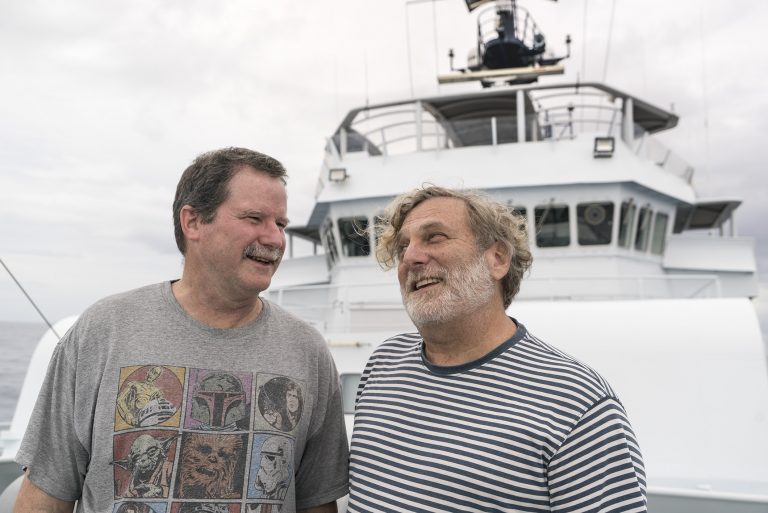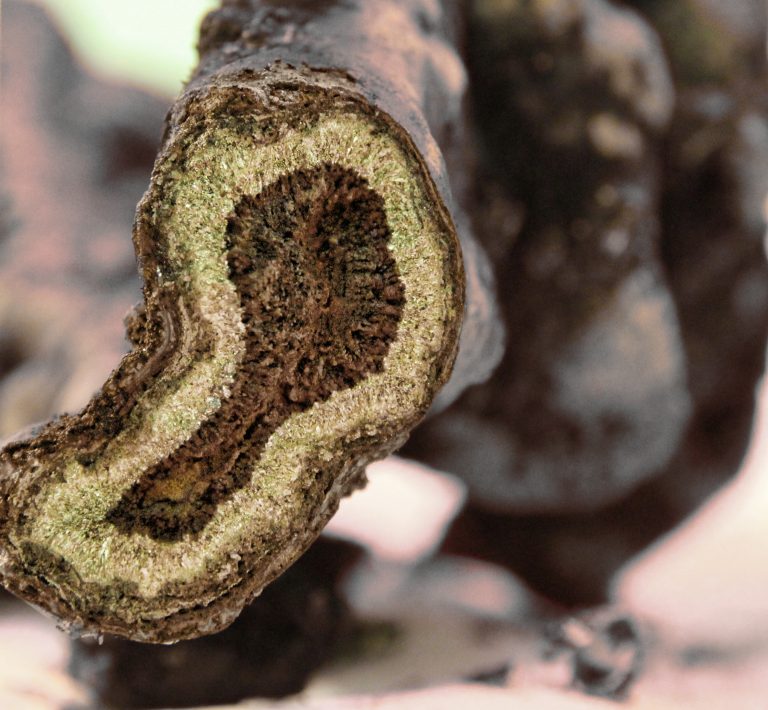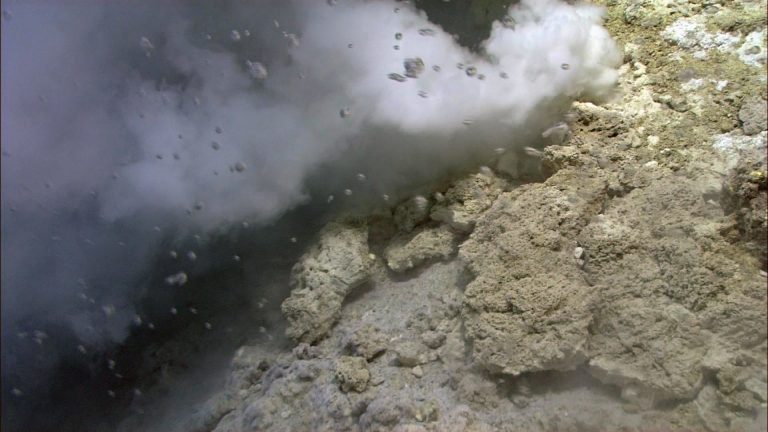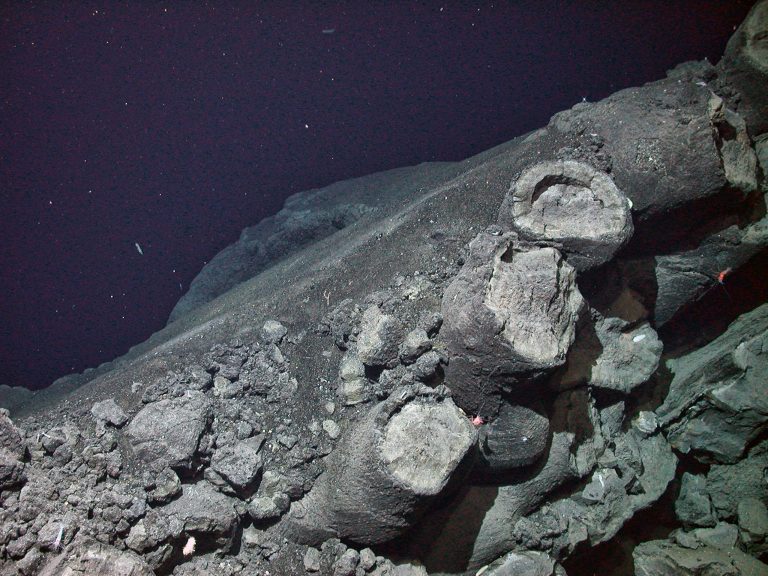With time, Co-Chief Scientists Drs. Ken Rubin and Bill Chadwick have developed a sort of Zen philosophy that enables them to cope with the ups and downs of science at sea. Making an expedition such as Underwater Fire happen is not easy. The process started years ago with writing proposals, battling uphill logistic fights, raising funds, and forming an effective research team. Once at sea, these scientists believe in the art of living in the present moment. They concentrate on making each stage of the research process a reality and a success, and worry about the next steps later.
An unrelenting love for discovery drives the scientists’ quest. Dr. Chadwick smiles when he says, “I love the thrill of figuring something out for the first time, like looking at a landscape and interpreting how it was formed.” He certainly knows what he is talking about, as Dr. Chadwick is the only scientist ever to have effectively predicted an underwater eruption after studying the Axial Seamount for years. Yet, since the tremendous effort invested is undeniable, it might be worth asking what some of the practical applications of this knowledge are. Here are four:

Mineral Extraction
The process of deep-sea mining for rare minerals formed in hydrothermal systems is in its first stages, but it is a reality. In order to determine the most appropriate ways to extract materials such as gold, silver, copper, manganese, cobalt, or zinc without adverse environmental impacts, more research needs to be conducted. Researchers and miners need to understand how hydrothermal vent systems work. “There are good aspects and bad aspects of this. One good one is that mineral extraction provides raw materials that are much needed in various industries on the planet. One of the perhaps negative aspects is that, if we don’t understand the ecology of the communities that live at these vents, and we don’t understand what role the perturbation of them through mining might play, then we potentially lose the opportunity to understand what these organisms are doing, how they form and how they were before they were perturbed,” Dr. Rubin says.

Ocean Acidification
Acidification of the oceans from dissolved carbon dioxide is a hot topic, especially when the world is developing strategies to better respond and adapt to climate change. In this scenario, underwater volcanoes play a very important role.
Most volcanoes produce extremely acidic gases (such as sulfur), along with other gases that are less acidic but much more abundant, such as carbon dioxide. The concentration, location, and depth of the sources of these gases effects their impact on seawater’s pH – especially in the deep ocean – making water more acidic. Over the last fifteen years scientists have discovered that some of those gases from underground sources have a larger impact on seawater – at least on a local level – than the carbon dioxide entering seawater from the atmosphere. The presumption is that if a system at the top of a volcano has a lot of acidity, those acids must be coming from magmatic gases. The global community cannot fully understand the impacts of carbon dioxide in the oceans until it is determined how much of it comes out of underwater volcanoes and where it is being produced.

Productivity
Productivity in the oceans is incredibly important for humankind. Phytoplankton are responsible for more than fifty percent of global primary production. They play a major role in the global carbon cycle by consuming carbon dioxide from the atmosphere and create oxygen. On top of that, they keep the marine food-chain going.
The oceans are an indispensable source of food. Experts do not fully understand how underwater volcanic activity and hydrothermal systems affect productivity in the oceans, but they are certain there is a link. Iron is a key piece of the puzzle. Dr. Joseph Resing explains: “When we think about the vast ocean, there are places at the surface of the ocean where there is sunlight, where we have abundant nitrogen, phosphorus, and potassium. Yet, you do not find lots and lots of phytoplankton growing. If you added iron to that seawater, the phytoplankton would grow. Iron can enter the ocean from dust, from rivers, from sediments, and some from hydrothermal activity. Trying to understand how all these sources act in concert to provide the missing ingredient to phytoplankton growth is an important thing to do.”
With climate change we know that some regions of the world will become more arid, and some less so. From that, we can assume that the production of dust, which is the major source of iron to the surface ocean, will vary in the future based on changes to climate. The scientists expect that the production of iron by hydrothermal activity should remain relatively consistent over time, and climate models that project how the oceans will behave must include that iron.
Hazard Prevention
Understanding underwater volcanoes can offer valuable opportunities for the development of effective hazard-reduction plans when it comes to eruptions, landslides and tsunamis. It is true that this statement relates more to shallower volcanoes than the Mata Volcanic Group, but some of the lessons could be applied to the understanding of volcanic activity in general. “It is always the case, especially in volcanology, that some of what we learn is local. It relates to that particular place, but some of what we learn allows us to develop an overall theory of how volcanoes work and how eruptions differ from place to place,” explains Dr. Rubin.
Putting together an expedition such as Underwater Fire takes a lot of patience, finances, and effort. The endeavor is completely worth it. The Mata volcanic system is always changing, presenting new research opportunities, challenging the experts and never failing to amaze those on Falkor, guaranteeing they will get to experience the exhilarating spark of discovery yet again.


